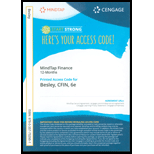
The bond has a maturity value of $1,000 and coupon rate of 7%. The bond was selling for $996 one year ago and today it Is selling for $1006.
Yield to maturity (YTM) of a bond is the required
YTM calculation is a trial and error process, however, we can calculate YTM using a financial calculator as follows:
INT = PMT = coupon amount
FV = M = maturity value
PV = Price of the bond (input as a negative value)
N = number of periods
Current yield is the annual income on the bond relative to the current price of the bond. It is calculated as the coupon divided by the price of the bond.
Value of a bond keeps changing depending on the prevailing interest rates. As the interest rate increases, the value of the bond decreases on the contrary as the interest rate decreases, price of the bond increases.
Want to see the full answer?
Check out a sample textbook solution
Chapter 6 Solutions
CFIN -STUDENT EDITION-ACCESS >CUSTOM<
- Principles of Accounting Volume 1AccountingISBN:9781947172685Author:OpenStaxPublisher:OpenStax College
 EBK CONTEMPORARY FINANCIAL MANAGEMENTFinanceISBN:9781337514835Author:MOYERPublisher:CENGAGE LEARNING - CONSIGNMENT
EBK CONTEMPORARY FINANCIAL MANAGEMENTFinanceISBN:9781337514835Author:MOYERPublisher:CENGAGE LEARNING - CONSIGNMENT Intermediate Financial Management (MindTap Course...FinanceISBN:9781337395083Author:Eugene F. Brigham, Phillip R. DavesPublisher:Cengage Learning
Intermediate Financial Management (MindTap Course...FinanceISBN:9781337395083Author:Eugene F. Brigham, Phillip R. DavesPublisher:Cengage Learning


